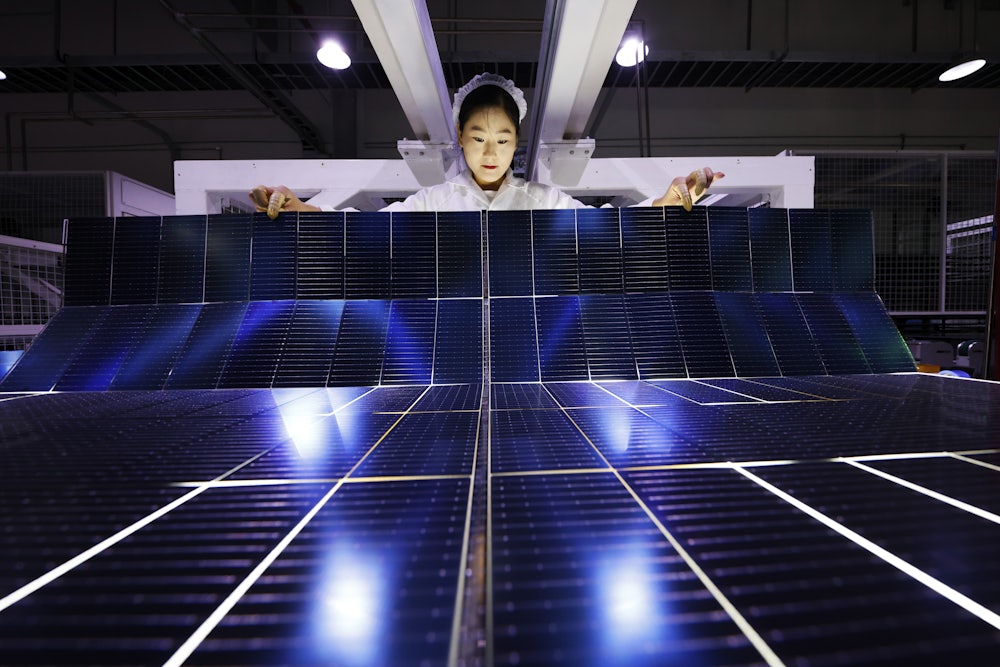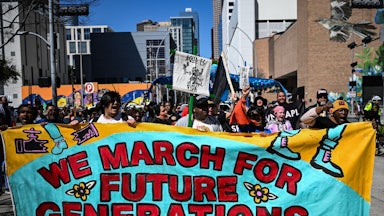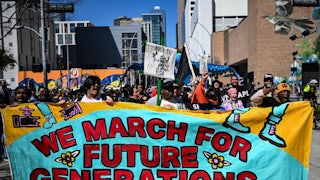The year is 1988, and the United States is on the cusp of a renewable energy revolution. Lithium batteries, electric motors, and photovoltaic solar panels were invented in the country; 85 percent of the world’s solar market was based here. And there was bipartisan political will to begin prioritizing non–fossil fuel energy sources. “Those who think we are powerless to do anything about the greenhouse effect forget about the ‘White House effect,’” George H.W. Bush said in a campaign speech after becoming the Republican nominee for president. “In my first year in office, I will convene a global conference on the environment at the White House. It will include the Soviets, the Chinese.… The agenda will be clear. We will talk about global warming.’’
The notion, then, was that the U.S. would have to drag China into cooperating. At that time, renewable energy was essentially nonexistent in China. In fact, the Communist government did not articulate clear goals for expanding its domestic clean energy industry until the release of its Twelfth Five-Year Plan, in 2010, when for the first time it identified the fight against climate change as a major challenge. That year, China had significantly less combined wind and solar capacity than the U.S.

Just a decade and a half later, China is manufacturing 92 percent of the world’s solar panels, 82 percent of wind turbines, and three-quarters of the world’s batteries. This dominance has dramatically reduced costs—Chinese solar panel prices dropped 40 percent in 2023 alone, and China’s BYD, the world’s largest electric vehicle manufacturer, now sells high-quality E.V.s for just $10,000—and sparked a clean energy explosion across the globe. It took from 1954 to 2022 for humanity to install one terawatt of solar capacity. Just two years later, in 2024, the world hit two terawatts. Pakistan went from basically zero solar capacity to 25 percent of all its electricity coming from solar in just a few years, with solar panel imports from China doubling between 2023 and 2024. Algeria imported 630 times more Chinese solar panels in the first half of 2025 than it had in 2024.
So it took less than 15 years for one global power (and not even the wealthiest or most technologically advanced one) to create a global energy market in which renewables are outcompeting fossil fuels, despite the trillions of dollars in economic and political subsidies that continue to structurally advantage oil and gas in profound ways. Meanwhile, 37 years after it seemed poised to dominate the clean energy transition, the U.S. has become a full-on petrostate.
So what happened? Here is where we see the most significant independent variable in the comparison between the U.S. and China—the response of their respective fossil fuel industries. Unlike China’s state-run coal companies, which never attacked climate science, in the United States, Big Oil began implementing a massive scheme to poison the public with climate denial in order to, as one 1988 internal Exxon memo put it, block the “development of nonfossil fuel resources.”
And that’s just what they did.
In 1991, a group of fossil fuel companies founded the Information Council on the Environment to “reposition global warming as theory (not fact).” ICE conducted polling that found that 80 percent of Americans thought the problem of climate change was serious. To dismantle this consensus, ICE planned to target “not typically active information-seekers” with climate-denying radio commercials, public relations tours, mailers, and newspaper advertisements featuring messages like, “Who told you the Earth was warming … Chicken Little?”
Then, in 1998, representatives from major fossil fuel companies produced the “Global Climate Science Communications Action Plan,” which outlined a multimillion-dollar campaign to make climate denial “part of the ‘conventional wisdom’” and laid out a series of strategies designed to flood Americans with false claims that there was no scientific consensus about the reality of climate change. These tactics included buying off “independent” scientists to spread climate denial, “advertising the scientific uncertainties” in various markets, and distributing their propaganda “directly to schools”—all tactics the fossil fuel industry went on to execute in the U.S. and across Europe.
Today, this decades-long campaign to fraudulently turn the public against climate action is the subject of dozens of lawsuits against oil companies by plaintiffs seeking damages for climate harms. These suits have great promise. But they also face massive obstacles, as you’d expect when taking on the most powerful corporations in the world.
One of the top arguments the fossil fuel industry has used to try to evade accountability for its fraud relates to causation. To hold a defendant liable for misconduct, a plaintiff has to demonstrate that the defendant’s actions were a substantial factor in causing harm to the plaintiff. Big Oil’s army of lawyers are quick to claim that, even if the fossil fuel industry did lie about climate change, plaintiffs cannot prove that these lies necessarily played a substantial role in driving climate damages.
There are different ways to try to demonstrate the causal impact of Big Oil’s deception. You can compare the actual scientific consensus on climate with the public’s perception of that consensus. The most recent analysis of the peer-reviewed scientific literature found that there is greater than 99 percent agreement on the existence and causes of man-made climate change, yet a 2015 Yale-George Mason University poll found that only one in 10 Americans understands this. As the Intergovernmental Panel on Climate Change, or IPCC, noted in its sixth assessment report, “Misinformation and politicization of climate change science has created polarization in public and policy domains in North America, particularly in the US, limiting climate action,” which, in turn, “inflates climate risks.”
But the recent history of clean energy development in China offers another compelling piece of evidence for this causal link. After all, causation is essentially determined by asking, “What would have happened if the conduct at issue had not occurred?” China provides that counterfactual. On the one hand, we have a superpower, the U.S., that was primed with every advantage to begin developing clean energy economies of scale more than three decades ago, but instead doubled down as a petrostate after its fossil fuel industry fraudulently polarized a substantial portion of its population against climate action. On the other hand, we have China—the one superpower in the world where those Western Big Oil companies don’t have influence and were not able to poison the well with their deception—which has in just a few years succeeded in remaking the global energy system such that renewables are now cheaper than fossil fuels.
It’s important to note this timescale, because the fight against climate change is fundamentally a race against time. And it’s a race that humanity is losing badly, as evidenced by the terrifying recent determination that the Earth has reached its first catastrophic climate tipping point—coral reefs have entered terminal decline, condemning vast swathes of the planet’s biodiversity and the livelihoods of hundreds of millions—and is on the brink of several others, including the destruction of the Amazon, the collapse of global ocean currents, and the loss of polar ice sheets.
The speed of the world’s renewable energy explosion following the prioritization of clean energy by a single global power proves that this dystopian timeline was far from inevitable. Absent Big Oil’s climate fraud, it is likely that the West could have achieved these clean energy milestones decades earlier, giving humanity more than enough time to transition off fossil fuels before we hit the apocalyptic tipping points we are currently hurtling toward. In other words, Big Oil’s lies did cause—or at the very least were a substantial factor in causing—the catastrophic climate harms we are experiencing today.
Of course, no historical counterfactual can be absolutely definitive. There are obviously many differences between the U.S. in the 1990s and China in the 2010s beyond the presence or absence of fossil fuel–funded campaigns of climate deception. But none of these differences strongly cut against the causation analysis. For example, you could argue that China, with its system of state control, could direct resources toward clean energy in a way the U.S. never could have. But the U.S. can clearly marshal vast resources for its priorities (think of the interstate highway system, the Apollo program, or the development of AI data centers) and had far more resources to marshal; in 2010, when China began its renewables buildout, its gross domestic product was just over one third that of the U.S.
You could also argue that it’s just not possible to compare what might have happened in the democratic U.S. to what did occur in the single-party autocracy of China. But the evidence does not indicate that a more democratic China, kept free of Big Oil’s propaganda, would have been less supportive of a clean energy buildout. Indeed, peer-reviewed national survey data on public demand for climate action finds that while the U.S. ranks at the bottom of the international list, China—the country that Western Big Oil companies have had the least ability to influence—is right up at the top, with 97 percent supporting demands for greater political action on climate.
I don’t know whether this argument will ever be used in a court of law. But every time you hear a piece of good news about the explosive growth of clean energy, it’s worth remembering that the benchmark in question likely could have been met in 2005, rather than 2025, if not for Big Oil’s climate deception. Every time you hear bad news about another catastrophic wildfire, drought, heat wave, or storm, or the nightmarish arrival of another cataclysmic climate tipping point, remember that we could have had 20 more years to address this crisis had Big Oil not stopped the West from taking earlier action.
Fossil fuel companies, in order to maintain their garish profits—and Big Oil executives, in order to buy their fourth homes and private jets and, increasingly, luxury bunkers—knowingly stole humanity’s best chance to address climate change on a timeline that would have averted apocalypse. It’s the most despicable crime in the history of our species. Hopefully human civilization can survive long enough for some measure of justice to be exacted against the scoundrels responsible.






